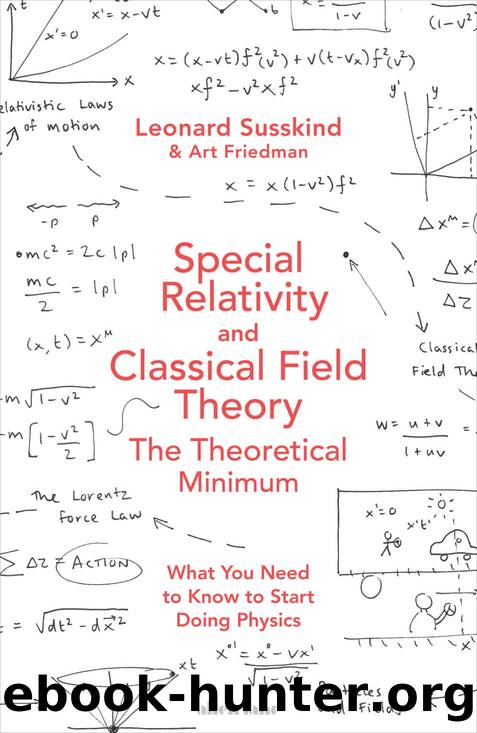Special Relativity and Classical Field Theory (Theoretical Minimum 3) by Leonard Susskind & Art Friedman

Author:Leonard Susskind & Art Friedman [Susskind, Leonard]
Language: eng
Format: azw3
ISBN: 9780241293362
Publisher: Penguin Books Ltd
Published: 2017-09-25T16:00:00+00:00
I.1 Units and Scale
The answer turned out to be that the numerical values of the so-called constants of nature actually have more to do with biology than physics.1 As an example, take the size of an atom, about 10−10 meters. But why do we measure in meters? Where did the meter come from and why is it so much bigger than an atom?
When asked this way, the answer starts to come into focus. A meter is simply a unit that’s convenient for measuring ordinary human-scale lengths. It seems that the meter arose as a unit for measuring rope or cloth and it was simply the distance from a man’s nose (supposedly the king’s nose) to his outstretched fingertips.
But that raises the question, why is a man’s arm so long—1010—in atomic radii? Here the answer is obvious: It takes a lot of atoms to make an intelligent creature that can even bother to measure rope. The smallness of an atom is really all about biology, not physics. You with me, Art?
And what about the speed of light; why so large? Here again the answer may have more to do with life than with physics. There are certainly places in the universe where things—even large, massive things—move relative to each other with speeds close to the speed of light. Only recently, two black holes were discovered to be orbiting each other at an appreciable fraction of the speed of light. They crashed into each other, but that’s the way it goes; moving that fast can be dangerous. In fact, an environment full of objects whizzing around at nearly the speed of light would be lethal for our soft bodies. So the fact that light moves very fast on the scale of ordinary human experience is, at least in part, biology. We can only live where things with appreciable mass move slowly.
Avogadro’s number? Again, intelligent creatures are necessarily big on the molecular scale, and the objects that we can easily handle, like beakers and test tubes, are also big. The quantities of gas and fluid that fill a beaker are large (in number of molecules) for reasons of convenience to our large soft selves.
Are there better units more suited to the fundamental principles of physics? Yes indeed, but let’s first recall that in standard textbooks we are told that there are three fundamental units: length, mass, and time. If, for example, we chose to measure length in units of the radius of a hydrogen atom, instead of the length of a man’s arm, there would be no large or small constants in the equations of atomic physics or chemistry.
But there is nothing universal about the radius of an atom. Nuclear physicists might still complain about the small size of the proton or, even worse, the size of the quark. The obvious fix would be to use the quark radius as the standard of length. But a quantum-gravity theorist would complain: “Look here, my equations are still ugly; the Planck length is 10−19 in your stupid nuclear physics units.
Download
This site does not store any files on its server. We only index and link to content provided by other sites. Please contact the content providers to delete copyright contents if any and email us, we'll remove relevant links or contents immediately.
| Electricity | Magnetism |
The Complete Stick Figure Physics Tutorials by Allen Sarah(7337)
Secrets of Antigravity Propulsion: Tesla, UFOs, and Classified Aerospace Technology by Ph.D. Paul A. Laviolette(5332)
Thing Explainer by Randall Munroe(3909)
The River of Consciousness by Oliver Sacks(3572)
The Order of Time by Carlo Rovelli(3162)
How To by Randall Munroe(3074)
A Brief History of Time by Stephen Hawking(2991)
I Live in the Future & Here's How It Works by Nick Bilton(2960)
What If?: Serious Scientific Answers to Absurd Hypothetical Questions by Randall Munroe(2667)
The Great Unknown by Marcus du Sautoy(2662)
Midnight in Chernobyl by Adam Higginbotham(2515)
Blockchain: Ultimate Step By Step Guide To Understanding Blockchain Technology, Bitcoin Creation, and the future of Money (Novice to Expert) by Keizer Söze(2467)
Networks: An Introduction by Newman Mark(2382)
The Meaning of it All by Richard Feynman(2318)
Easy Electronics by Charles Platt(2308)
The Tao of Physics by Fritjof Capra(2247)
Midnight in Chernobyl: The Untold Story of the World's Greatest Nuclear Disaster by Adam Higginbotham(2195)
When by Daniel H Pink(2098)
Introducing Relativity by Bruce Bassett(2097)
